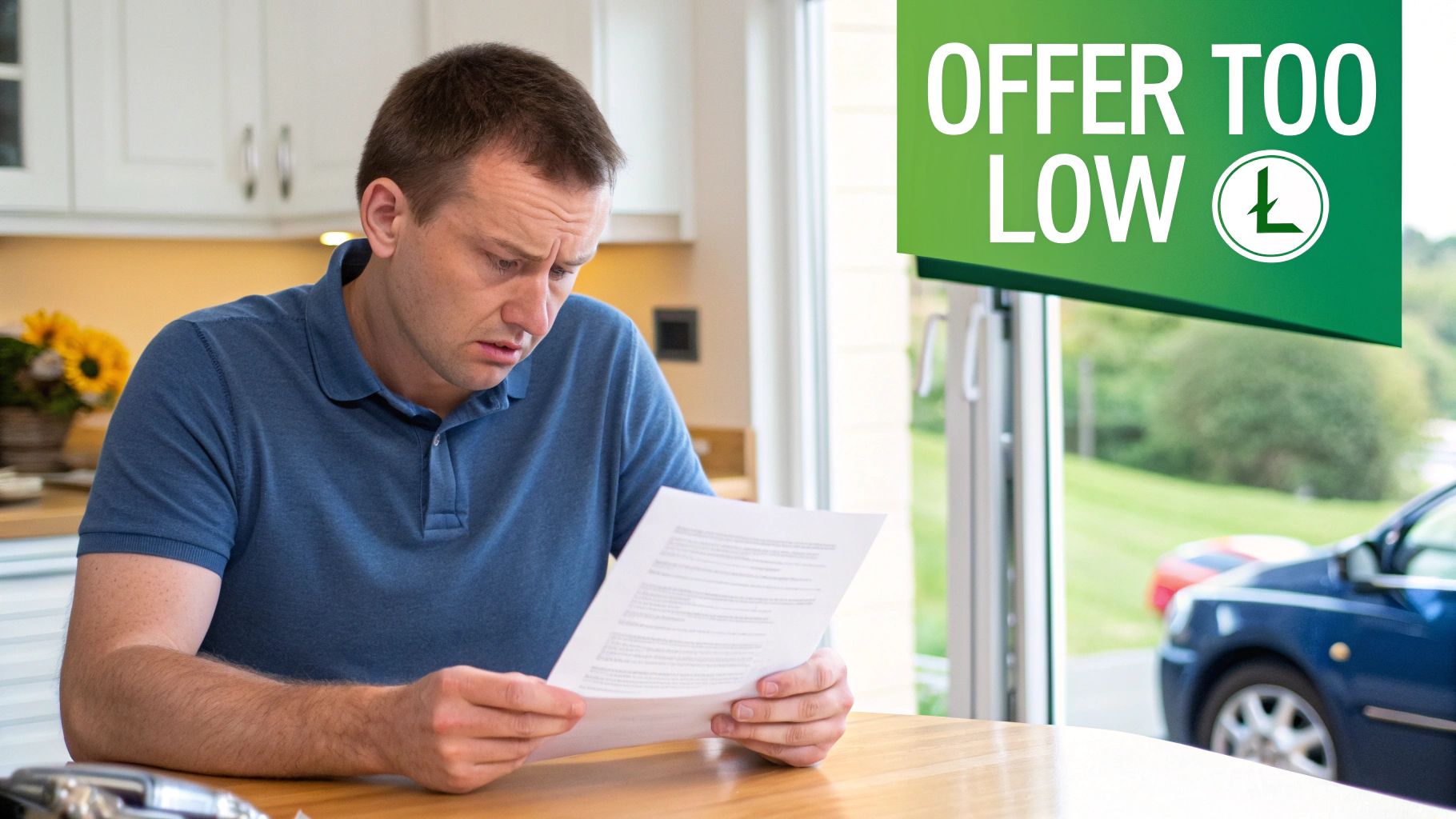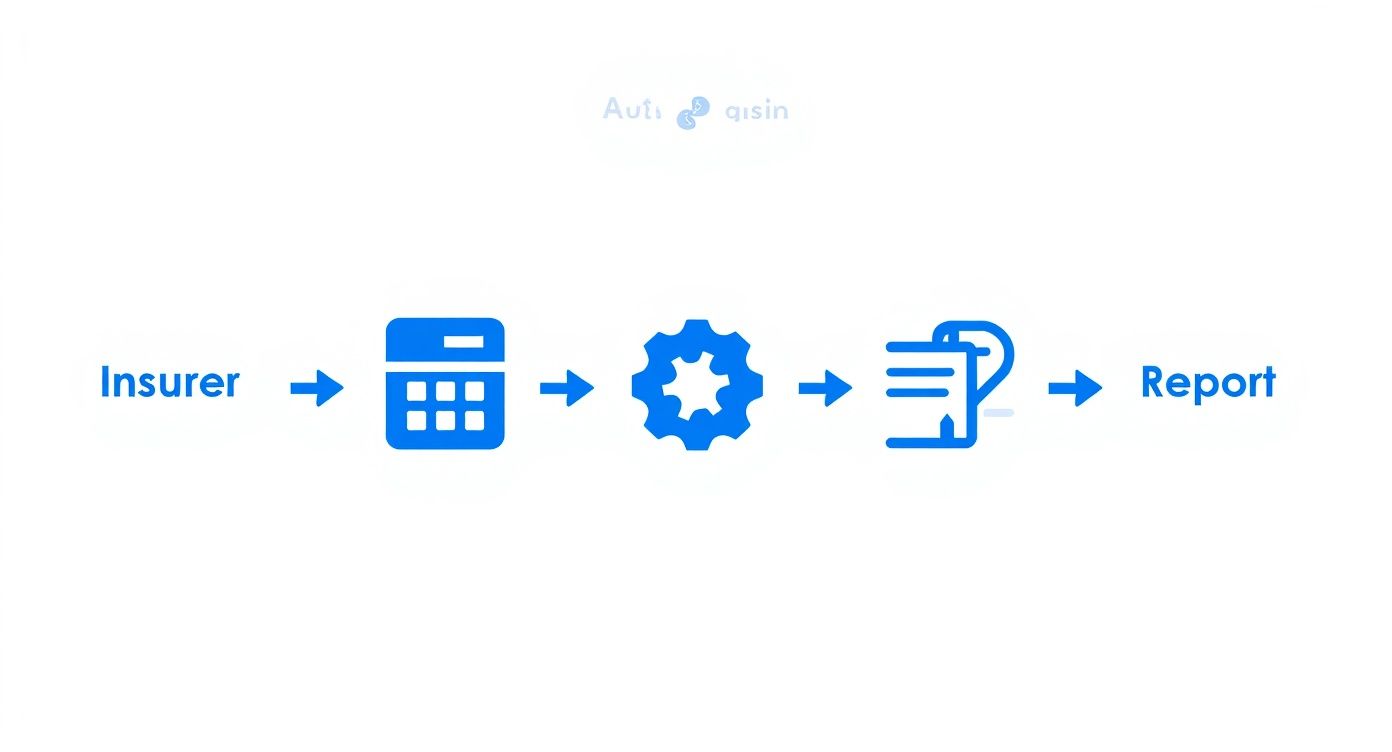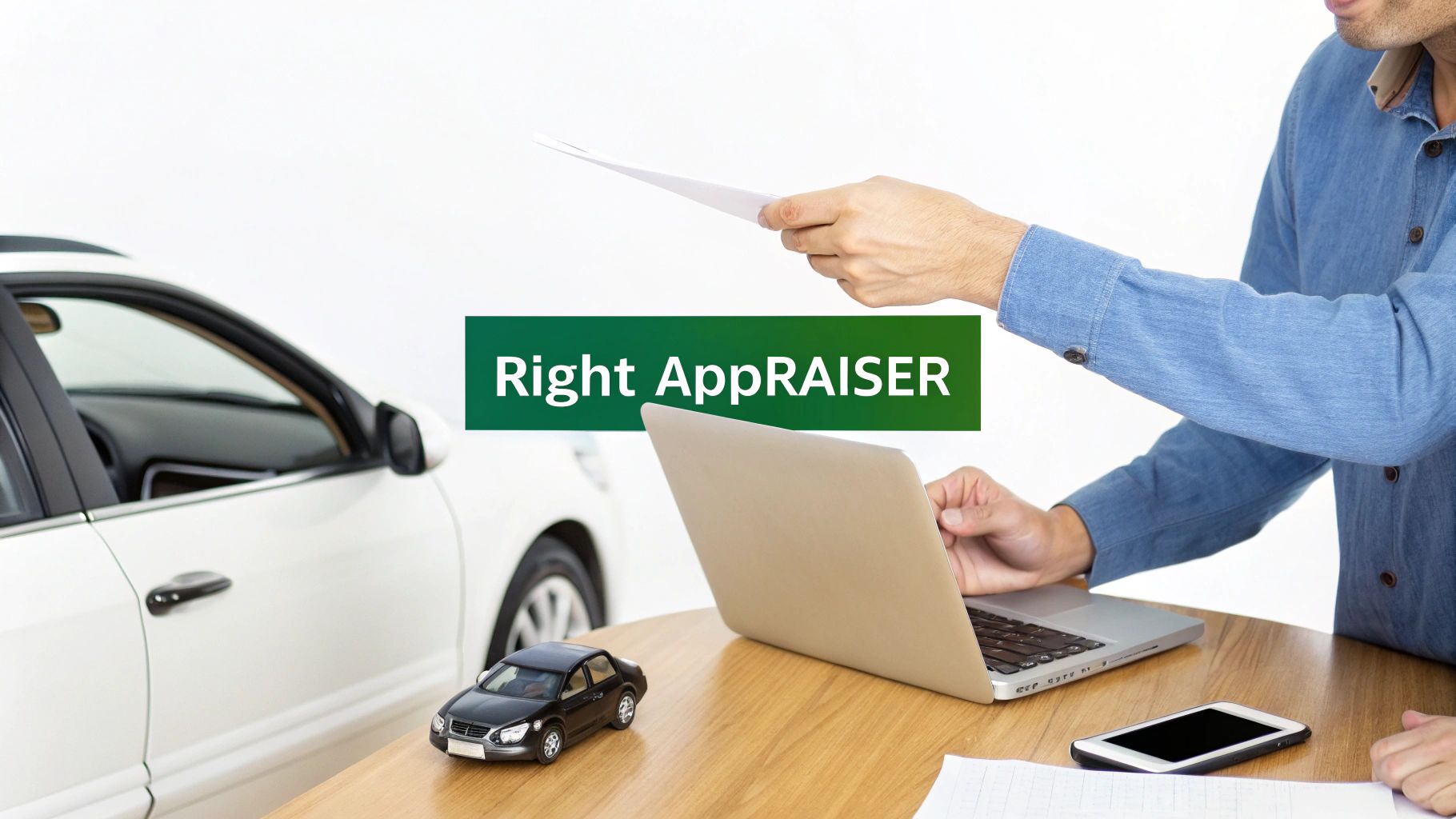That first settlement offer from your insurance company can feel like a huge relief—until you realize it’s shockingly low. If that number made your stomach drop, you’re not alone. The good news is you don’t have to accept it.
An independent auto insurance appraisal is your best defense against a lowball offer. It provides the professional, data-backed evidence you need to show the insurance company what your vehicle was really worth and negotiate for the compensation you deserve.
Why Initial Insurance Offers Miss the Mark
When an insurer sends a settlement for a total loss or diminished value claim, they’re usually looking to close the case as quickly and cheaply as possible. Unfortunately, that efficiency often comes at your expense.
Their valuation is almost always generated by automated software that uses generic data, completely missing the unique story of your vehicle. This software can’t account for your car’s excellent condition, recent upgrades, or desirable features, leading to an inaccurate and unfair lowball offer.

Common Reasons for a Lowball Offer
Treat the insurer’s initial number as what it is: a starting point for negotiation, not the final word. Their automated systems are designed for speed, not accuracy, and make predictable errors that a certified human appraiser can easily spot and correct.
Here are the most common reasons their offer is too low:
- Using Flawed Comparables: The software often pulls “comps” (comparable vehicles) from different states where cars are cheaper. It might even compare your fully-loaded, top-tier model to a stripped-down base model.
- Ignoring Vehicle Condition: A generic report assumes your car has average wear and tear. It doesn’t know you kept it garage-parked, maintained it meticulously, or had an immaculate interior.
- Overlooking Recent Upgrades: Did you just install new tires or a high-end sound system? The algorithm almost never accounts for recent investments that add real value to your vehicle.
- Relying on Outdated Data: The used car market moves fast. An insurer’s report might use old sales data that doesn’t reflect what your car is actually selling for today, resulting in a lower valuation.
Understanding these flaws is the first step. The next is to fight back with credible evidence. For a complete game plan, check out our step-by-step guide to disputing a total loss offer.
Decoding Total Loss vs. Diminished Value Appraisals
When you’re dealing with an insurance claim, the jargon can be confusing. But getting a fair payout starts with knowing what kind of claim you’re dealing with. Two situations almost always require a professional auto insurance appraisal: total loss claims and diminished value claims.
A total loss claim is about getting paid for a car that’s gone for good. A diminished value claim is about recovering the lost resale value on a car that’s been repaired but is now permanently marked by its accident history.
Total Loss Appraisals: Establishing Your Car’s Pre-Accident Value
A car is declared a total loss when repair costs exceed a certain percentage of its value right before the accident (a threshold set by state law). The insurer is supposed to pay you the Actual Cash Value (ACV)—what your car was worth the moment before impact.
The problem? Their ACV is often far too low. An independent total loss appraisal provides the hard evidence you need to prove the real fair market value, factoring in all the details that made your car special. This number should be enough for you to buy a truly comparable replacement.
To learn more, check out our complete Total Loss guide.
Diminished Value Appraisals: Proving Your Car’s Lost Resale Value
A diminished value claim comes into play after your car has been repaired. Even if it looks perfect, its accident history is now a permanent scar on vehicle history reports like CarFax. This history makes your car harder to sell, causing a significant drop in its resale value. This loss is called inherent diminished value.
Imagine a buyer looking at two identical used cars. One has a clean history, while the other has a record of major collision repairs. Which one would they pay more for? The clean one. That price difference is the money you’re entitled to claim, and a diminished value appraisal provides the certified proof you need.
Total Loss vs Diminished Value Appraisals at a Glance
This table breaks down the two main types of auto insurance appraisals.
| Appraisal Type | Purpose | When It’s Used |
|---|---|---|
| Total Loss Appraisal | To determine your vehicle’s full pre-accident market value. | When your vehicle is declared a “total loss” and you need to challenge the insurance company’s low settlement offer. |
| Diminished Value Appraisal | To calculate the loss in resale value after repairs are complete. | After your vehicle has been repaired, but its market value has dropped due to the accident history. |
Ultimately, both kinds of auto insurance appraisals have the same mission: to arm you with the data-backed evidence required to negotiate a fair and accurate insurance settlement. To see how these rules apply where you live, take a look at our state-specific law pages.
How Insurers Calculate Value (And Where They Go Wrong)
Ever wonder how your insurance company came up with their settlement number? Most use automated software from third-party valuation companies. These systems crunch generic data to determine your car’s worth, prioritizing speed and low cost over accuracy.
This one-size-fits-all approach is where things go wrong for you. The software is only as smart as the data it’s fed—and that data often misses the mark completely.
The Problem with Automated Valuations
An automated system can’t grasp the unique qualities of your car, which leads to a lowball offer that doesn’t reflect its true pre-accident condition. This is where a hands-on auto insurance appraisal from a human expert makes all the difference.
Here are the most common ways these automated systems shortchange you:
- Bad Comparisons: The software might compare your fully-loaded, low-mileage SUV against a base model sitting on a lot hundreds of miles away in a different market.
- Ignoring Upgrades: It almost never factors in valuable additions you’ve made, like a premium sound system, custom wheels, or even brand-new tires.
- Overlooking Condition: An algorithm can’t see that your car was meticulously maintained, garage-kept, and had a spotless interior. It just assumes average wear and tear.
Insurers also cut costs by basing repair estimates on cheaper aftermarket parts instead of higher-quality original equipment. Knowing the differences between OEM vs Aftermarket Parts can give you an edge in negotiations.
Spotting the Red Flags in Their Report
When you get the insurer’s valuation report, don’t just glance at the final number. Dig into the details. Look closely at the “comparable” vehicles they chose. Are they really comparable in trim, mileage, and options? Did they apply an unfair “condition adjustment” to your car without a good reason?
Pro Tip: Watch out for negative adjustments for things that are normal for a car’s age, like minor paint chips. Insurers use these small deductions to chip away at your total payout, hoping you won’t notice.
An independent auto insurance appraisal from SnapClaim is your best defense. Our reports are built on hard evidence, focusing on your car’s specific history, features, and local market conditions to establish its genuine value.
Your Step-by-Step Guide to Getting an Independent Appraisal
Going toe-to-toe with an insurance company can feel intimidating, but getting an independent appraisal is a straightforward process designed to put you back in control. Follow these simple steps to build a powerful case for the settlement you deserve.
Step 1: Gather Your Key Documents
Before ordering an appraisal, pull together some basic paperwork. Having these documents ready makes the process faster and more accurate.
Here’s what you’ll typically need:
- The Police Report: Provides an official, unbiased account of the accident.
- The Insurer’s Valuation Report: This is the document with their lowball offer and questionable “comparable” vehicles.
- Repair Estimates and Invoices: For diminished value claims, these papers show the full extent of the damage and work performed.
- Photos of Your Vehicle: Pictures from before and after the accident are crucial for showing your car’s true condition.
Step 2: Find a Certified Appraiser
Next, find a reputable, certified appraiser whose report will hold up under scrutiny. You need an expert who uses a data-driven approach and is trusted by industry professionals.
SnapClaim connects you with certified appraisal services that deliver solid, defensible reports quickly, giving you the ammo you need to negotiate. You can learn more about the typical cost of a car appraisal report.

Step 3: Complete the Vehicle Inspection
The appraiser will need to perform a thorough inspection of your vehicle. While this used to require an in-person visit, many modern appraisal services like SnapClaim can handle this virtually.
You’ll receive instructions on how to take specific photos and videos of your car. This virtual method is faster and more convenient, giving the appraiser all the visual proof needed to assess its true condition and features.
Step 4: Review Your Certified Report
Once the inspection is done, the appraiser gets to work. They’ll analyze local market data, sales trends, and your vehicle’s specific details to build a comprehensive report. This document will clearly state your car’s Actual Cash Value (for a total loss) or its diminished value.
A professional appraisal report is more than just a number. It’s a detailed, evidence-based argument that dismantles the insurer’s low offer and proves the true amount you are owed.
Step 5: Submit Your Evidence to the Insurer
With your certified auto insurance appraisal in hand, you’re ready to formally challenge the insurer’s offer. Send the report to the adjuster with a professional letter or email explaining that their initial valuation was inaccurate. This data-backed evidence forces them to re-evaluate your claim based on facts, not flawed software.
Negotiating a Better Settlement with Your Appraisal Report
Your certified auto insurance appraisal report is your most powerful negotiation tool. Armed with this evidence, you can confidently push back against a lowball offer and steer the conversation toward a fair number.
The key is to stay professional, stick to the facts, and state your case clearly. Your goal isn’t to start a fight; it’s to present new, accurate information that their system missed. You’re helping the adjuster understand why their valuation fell short and giving them the proof needed to justify a higher payout.
Presenting Your Evidence
When you contact the adjuster, lead with the facts. A certified appraisal shifts the conversation from opinion to objective data, giving you a huge advantage.
Send a concise, professional email that includes:
- Your Claim Number: This helps them find your file instantly.
- A Clear Statement: Inform them you are formally disputing their valuation and have obtained an independent appraisal.
- The Appraisal Report: Attach the full report as a PDF.
- Your Counteroffer: Clearly state the value from your report and request that they adjust your settlement to match it.
Before you send it, make sure you understand the document. Our guide on how to read an appraisal report can help you get comfortable with all the key sections.
What Is the Appraisal Clause?
What happens if the insurance company still won’t budge? Your policy likely has a powerful tool called the appraisal clause. This provision is a built-in process for settling valuation disagreements without going to court.
Invoking the appraisal clause requires both you and the insurer to hire separate, independent appraisers. If those two can’t agree on a value, they bring in a neutral “umpire” who makes the final, binding decision.
While the auto insurance market continues to grow, with projections hitting $1,655.84 billion by 2033, legal protections like the appraisal clause ensure you always have the right to a fair, human-led dispute process.
How to Choose the Right Auto Insurance Appraiser
The success of your claim often comes down to the credibility of your appraiser. Not all auto insurance appraisals are created equal, and picking the right expert is essential if you want your report to stand up to an insurance company’s scrutiny.
You’re not just looking for a second opinion—you need a partner who can build a rock-solid, data-driven report that demands respect. A real pro will have a proven track record handling claims just like yours, whether for a total loss or diminished value.

Key Qualities of a Credible Appraiser
Here’s a checklist to ensure you’re working with a top-tier appraiser:
- Industry Certifications: Look for recognized credentials like I-CAR or ASE certifications. These prove a high level of professional training and industry knowledge.
- Transparent Methodology: The appraiser should be able to explain exactly how they determine a vehicle’s value. SnapClaim’s methodology is reviewed by licensed professionals to align with industry-accepted practices.
- Positive Customer Reviews: See what other vehicle owners are saying. Strong, genuine testimonials are a great sign of a reliable and effective service.
- Specialized Experience: Ensure they have expertise in your specific claim type. A diminished value claim requires a different approach than a total loss appraisal.
Modern car repairs are increasingly complex. Today, over 31% of repair estimates involve procedures for advanced driver assistance systems (ADAS). This highlights the need for specialized expertise, as detailed in recent analyses on the growing complexity of modern appraisals. Choosing an expert, like those who power SnapClaim’s reports, ensures your claim is backed by accurate, defensible data.
Frequently Asked Questions About Auto Insurance Appraisals
Here are answers to some of the most common questions vehicle owners have about auto insurance appraisals.
Can I get an independent appraisal if the accident was my fault?
Yes, absolutely. Your right to a fair settlement for a total loss comes from your own collision or comprehensive coverage, regardless of who was at fault. If you believe your insurance company’s total loss payout is too low, you have the right to get an independent appraisal to challenge their offer and establish your car’s true pre-accident value.
Can I claim diminished value if the accident wasn’t my fault?
In most states, yes. You can file a diminished value claim against the at-fault driver’s insurance company. Since their client’s negligence caused your property to lose value, their policy is responsible for making you whole. However, you generally cannot claim diminished value from your own insurance policy.
How much does an auto appraisal cost?
Think of an appraisal as a small investment to prevent you from leaving thousands of dollars on the table. Spending a few hundred dollars can provide the leverage needed to recover a much larger settlement. At SnapClaim, we make this a risk-free decision.
If your insurance recovery from the claim is less than $1,000, SnapClaim refunds the full appraisal fee — guaranteed.
Is an online estimator the same as a certified appraisal?
No, and this is a critical distinction. An online tool like Kelley Blue Book provides a general price range but lacks the detailed analysis needed for an insurance negotiation. An appraisal from a service like SnapClaim is a comprehensive, defensible report built on a detailed inspection and hyper-local market data, providing the official proof required to formally challenge a lowball offer.
About SnapClaim
SnapClaim is a premier provider of expert diminished value and total loss appraisals. Our mission is to equip vehicle owners with clear, data-driven evidence to recover the full financial loss after an accident. Using advanced market analysis and industry expertise, we deliver accurate, defensible reports that help you negotiate confidently with insurance companies.
With a strong commitment to transparency and customer success, SnapClaim streamlines the claim process so you receive the compensation you rightfully deserve. Thousands of reports have been delivered to vehicle owners and law firms nationwide, with an average of $6,000+ in additional recovery per claim.
Why Trust This Guide
This guide was reviewed and verified by SnapClaim’s auto appraisers, who specialize in diminished value and total loss disputes.
Our team continually updates every article to reflect current insurer guidelines, valuation standards, and court-accepted appraisal practices, ensuring that you’re relying on information trusted by professionals nationwide.
Get Started Today
Whether you’re challenging a low total loss settlement or proving your vehicle’s post-repair loss in value, SnapClaim makes it simple to take the next step.
Generate a free diminished value or total loss estimate in minutes and see how much compensation you may be owed.
👉 Get your free estimate today




